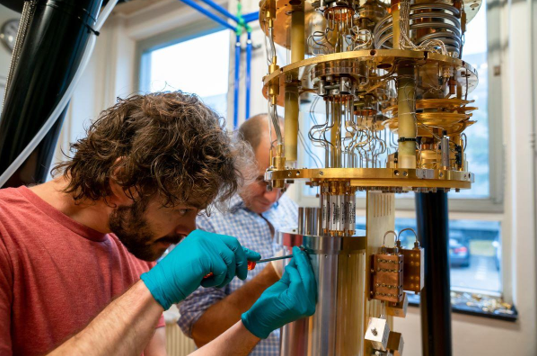英特尔在量子计算领域的努力开始出成果了。英特尔首次公布旗下的Horse Ridge低温控制芯片是在两年前。研究人员日前演示了该技术已经实现了最初的承诺,进而为量子计算机迈向更加实用的阶段铺平了道路。

英特尔与QuTech合作开发出量子控制方法。(图片:Tim Herman /英特尔公司)
Intel's quantum computing efforts are starting to show tangible results: two years after the company first unveiled its Horse Ridge cryogenic control chip, researchers have demonstrated that the technology is delivering on its original promise, and paving the way for quantum computers to become more practical.
英特尔在量子计算领域的努力开始出成果了。英特尔首次公布旗下的Horse Ridge低温控制芯片是在两年前。研究人员日前演示了该技术已经实现了最初的承诺,进而为量子计算机迈向更加实用的阶段铺平了道路。
Practicality, in effect, is not quantum devices' most remarkable trait. In their current format, quantum computers rely on quantum chips that need to be cooled down to extreme temperatures, in order to exert better control over the fragile qubits on the processor. Typically, qubits operate at 20 millikelvin, or about –273 degrees Celsius – temperatures that are even colder than outer space.
实用性目前还不是量子设备可以用来炫耀的特征。目前的量子计算机仍需要被冷却到极端温度的量子芯片,目的是可以对处理器上脆弱的量子比特进行更好的控制。通常情况下量子比特在20毫开尔文(大约-273摄氏度)的温度下运作,这样的温度甚至比外太空还要冷。
But to interact with the qubits, whether to control their behavior or read their state, flesh-and-bone scientists work in room-temperature environments, with room-temperature instruments. And since control electronics struggle to perform well at cryogenic temperatures, each qubit has to be linked to the instruments with a single wire.
而科学家们在与量子比特互动(例如控制量子比特的行为或是读取量子比特的状态)时都是在室温环境下进行,仪器也是装在室温环境里。由于控制电子装置在低温下的性能不佳,每个量子比特都必须用一根电线连在仪器上。
It's easy to see why the set-up might become problematic as scientists contemplate the possibility of scaling up quantum computers to millions of qubits. This hurdle has become known as the "wiring bottleneck".
不难看出,科学家们在考虑将量子计算机的规模扩大到数百万量子比特时,这样的设置可能存在一些问题。这个障碍人称 “布线瓶颈”。
This is why, a few years ago, Intel teamed up with QuTech – a collaboration between Delft University of Technology and the Netherlands Organization for Applied Scientific Research – to work on another approach to the problem.
几年前英特尔与QuTech(Delft理工大学和荷兰应用科学研究组织之间的合作项目)开始合作研发另一种解决该问题的方法。
It took the form of a new control chip designed to withstand the cold and operate as close as possible to the quantum processor, which Intel unveiled for the first time in 2019. The device was named Horse Ridge – a reference to the coldest place in Oregon, which is also the state where the Intel lab resides.
两家的研究采用一种新的控制芯片形式,控制芯片需要抵御寒冷并在尽可能接近量子处理器的地方运行,英特尔2019年首次公布了该款芯片。芯片的代号是Horse Ridge——Horse Ridge是英特尔实验室所处的俄勒冈州最冷的地方。
Horse Ridge was built on Intel's 22-nanometer FinFET Low Power technology, and was presented as a potential way to bring key control functions for quantum computer operations directly into the cryogenic refrigerator, closer to the qubits themselves.
Horse Ridge基于英特尔的22纳米FinFET低功耗技术,Horse Ridge旨在能让量子计算机操作的关键控制功能可以置于低温冰箱里,可以更接近量子比特。
The underlying premise was that, if Horse Ridge could achieve the same level of control as room-temperature instruments, then the wiring bottleneck could be significantly reduced.
但基本前提是Horse Ridge能够达到与室温仪器相同的控制水平,那么布线的瓶颈就可以大大减少。
Horse Ridge was subsequently tweaked, and a second generation of the chip was showcased last year; but now, for the first time, Intel's researchers have demonstrated that the technology is as capable of controlling qubits as its room-temperature-based equivalents.
Horse Ridge后来又进行了一些改进,去年展示了第二代Horse Ridge芯片。到了现在,英特尔的研究人员首次证明了Horse Ridge技术能够像旗下基于室温的同类产品一样控制量子比特。
The research team used Horse Ridge to run a two-qubit algorithm called the Deutsch-Jozsa algorithm, and found that the cryogenic chip performed well despite the cold environment, and achieved control of the qubits with a same level of fidelity (99.7%) as room-temperature electronics.
研究小组利用Horse Ridge运行名为Deutsch-Jozsa算法的双量子比特算法,研究小组还发现尽管环境寒冷,但低温芯片表现颇佳,而且还实现了量子比特控制,保真度(达99.7%)与室温电子产品相同。
"Our research results, driven in partnership with QuTech, quantitatively prove that our cryogenic controller, Horse Ridge, can achieve the same high-fidelity results as room-temperature electronics while controlling multiple silicon qubits," said Stefano Pellerano, principal engineer at Intel Labs.
英特尔实验室首席工程师Stefano Pellerano表示,“我们与QuTech公司合作推动的研究结果从量的角度证明了我们的低温控制器Horse Ridge在控制多晶片量子比特时可以达到与室温电子器件相同的高保真结果。”
Horse Ridge is a silicon-based CMOS chip, and as such was designed with a technology similar to that used in conventional microprocessors. The device was adapted to ensure the right operation even at cryogenic temperatures, which enables the chip to manipulate the state of qubits thanks to radio frequency pulses.
Horse Ridge是一款基于硅的CMOS芯片,因此在设计时采用了类似于传统微处理器的技术。Horse Ridge器件进行过一些修改以确保即使在低温下也能正确运行,芯片最后可以通过射频脉冲操纵量子比特的状态。
The qubits manipulated by Horse Ridge are also silicon-based, contrary to the type of qubits that can be found, for example, in IBM or Google's quantum computers, which are superconducting qubits. While Intel initially pursued both approaches – superconducting as well as silicon qubits – the company's recent efforts have ramped up in the latter.
Horse Ridge操纵的量子比特也是基于硅,与诸如在IBM或谷歌的量子计算机里可以找到的量子比特类型相反,后者是超导量子比特。英特尔最初同时在超导及硅量子比特两种方法上双管齐下,但最近加强了在硅量子比特方面的研究工作。
This is because researchers are increasingly acknowledging that building quantum computers with techniques that are similar in nature to those used to produce most modern-day electronics could come with huge advantages when it comes to scaling the technology.
原因是研究人员认识到,如果能用与生产大多数现代电子产品相似的技术来构建量子计算机,在技术规模扩展方面会有巨大优势。
What's more: with both qubits and the controller chip fabricated in silicon, Intel's researchers are hoping that it may be possible to one day fully integrate them both together in one die or package. This would greatly simplify the wiring challenge of quantum and enable strides in quantum scalability.
更重要的是,由于量子比特和控制芯片都是用硅制造的,英特尔的研究人员希望有一天能够将二者完全整合在一个芯片或组件里。如此可大大简化量子的布线并在量子可扩展性方面实现大幅提升。
"These innovations pave the way for fully integrating quantum control chips with the quantum processor in the future, lifting a major roadblock in quantum scaling," said Pellerano.
Pellerano 表示,“这些创新为未来能够将量子控制芯片与量子处理器完整整合铺平道路及扫除量子扩展方面的一个主要障碍。”
With these new results, Intel is cementing the company's position in the fast-evolving quantum ecosystem. While much of the focus remains on the qubits themselves, and on improving quantum processors, the Santa Clara giant has established that it is adopting a different course of action, instead working on developing the interconnects and control electronics that will create a quantum stack.
英特尔正在利用这些新成果巩固自己在快速发展的量子生态系统里的地位。目前的大部分注意力仍然集中在量子比特本身以及改进量子处理器上,但另一方面也显示这家总部设在圣克拉拉科技巨头在采取不同的行动方案,而不是致力于开发创建量子堆栈的互连和控制。
Integrating those systems, according to Intel, will be as important a piece of the puzzle to achieve quantum practicality.
据英特尔称,将这些系统整合在一起必将是实现量子实用性的重要一环。
